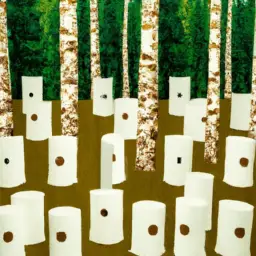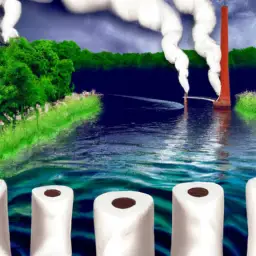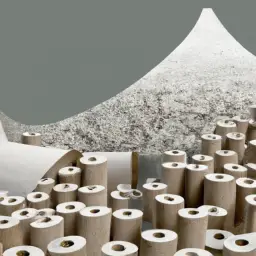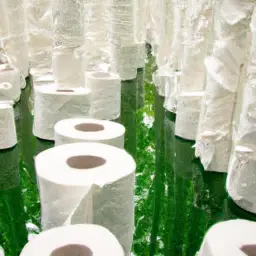Hey there! Did you know that conventional toilet paper has some surprising impacts on our planet?
In this article, I’m going to share with you eight eye-opening facts about the environmental consequences of using traditional toilet paper.
From deforestation and water pollution to energy consumption and wildlife impact, you’ll discover the hidden costs behind this everyday item.
So, grab a seat and get ready to learn how our choice of toilet paper can make a big difference in our planet’s health.
Environmental Consequences of Traditional Toilet Paper Production

As I delve into the topic of traditional toilet paper production, I’m struck by the environmental consequences it brings about. The process of making conventional toilet paper heavily relies on deforestation, which is a major concern for our planet. Every year, millions of trees are cut down to produce toilet paper, leading to the destruction of valuable forests and the loss of habitats for countless species. This not only disrupts the delicate balance of our ecosystems but also contributes to climate change.
However, there are alternatives to this environmentally harmful practice. Sustainable toilet paper options are gaining popularity as people become more conscious of their impact on the planet. These alternatives are made from recycled materials, such as post-consumer recycled paper or bamboo. By using these sustainable options, we can reduce the demand for virgin wood pulp, which means fewer trees are cut down.
In addition to using recycled materials, some companies are exploring innovative ways to produce toilet paper without contributing to deforestation. For example, there are companies experimenting with using agricultural waste, such as wheat or rice straw, as a source of fiber for toilet paper production. These alternatives not only help reduce deforestation but also provide a valuable use for agricultural by-products that would otherwise go to waste.
Deforestation and Its Link to Conventional Toilet Paper

My research on conventional toilet paper has uncovered a troubling link between its production and deforestation. Deforestation is the process of clearing forests to make space for industrial activities, and it has significant consequences for our planet.
The production of conventional toilet paper relies heavily on the use of virgin wood pulp, which comes from cutting down trees. This massive demand for wood pulp contributes directly to deforestation, leading to the destruction of valuable ecosystems and the loss of biodiversity.
The consequences of deforestation are far-reaching. It not only disrupts the delicate balance of our ecosystems but also contributes to climate change. Trees play a crucial role in absorbing carbon dioxide, a greenhouse gas that contributes to global warming. By removing trees, we’re reducing the Earth’s capacity to mitigate the negative impacts of carbon emissions.
To address this issue, it’s essential to consider sustainable alternatives to conventional toilet paper. One option is to switch to recycled toilet paper, which is made from post-consumer waste paper. This reduces the demand for virgin wood pulp and helps decrease deforestation. Additionally, bamboo toilet paper is gaining popularity as a sustainable alternative because bamboo is a fast-growing plant that requires fewer resources to cultivate.
Water Pollution Caused by Traditional Toilet Paper Manufacturing

I’ve discovered that traditional toilet paper manufacturing contributes to water pollution, posing a significant threat to our water ecosystems. The process involves bleaching the wood pulp used to make toilet paper, which releases harmful chemicals such as chlorine into the water. These chemicals can have devastating effects on aquatic life and contribute to water scarcity by contaminating our freshwater sources.
To illustrate the impact of traditional toilet paper manufacturing on water pollution, let’s take a look at the following table:
| Water Pollution Caused by Traditional Toilet Paper Manufacturing | |
|---|---|
| Issue | Impact |
| Chemical runoff from bleaching process | Contaminates water sources, harming aquatic life |
| Discharge of wastewater containing toxins | Pollutes rivers and streams |
| Deforestation for pulp production | Leads to soil erosion and further water pollution |
Considering the environmental consequences of traditional toilet paper, it is essential to explore alternative options that are more sustainable. Switching to eco-friendly alternatives such as recycled toilet paper or bamboo toilet paper can help reduce water pollution and conserve natural resources. These alternatives are made from renewable materials and often use less water and chemicals during production.
Energy Consumption in the Production of Conventional Toilet Paper

During the production of conventional toilet paper, significant amounts of energy are consumed. Energy efficiency is a critical consideration in the manufacturing process, as it directly impacts the environmental footprint of the product. Conventional toilet paper production requires large amounts of electricity and fossil fuels to power the machinery and equipment used in the process. This energy consumption contributes to greenhouse gas emissions and further exacerbates the negative impact on the planet.
However, there are sustainable alternatives to conventional toilet paper that can help reduce energy consumption. One such alternative is recycled toilet paper, which is made from post-consumer waste paper. The production of recycled toilet paper requires less energy compared to virgin toilet paper, as it eliminates the need for raw materials extraction and processing. Additionally, recycled toilet paper helps reduce landfill waste and conserves valuable resources.
Another sustainable option is bamboo toilet paper. Bamboo is a fast-growing plant that requires fewer resources and less energy to cultivate compared to traditional trees used for toilet paper production. Bamboo also has a high yield per acre, making it a more efficient and sustainable alternative. By choosing bamboo toilet paper, consumers can contribute to reducing energy consumption and promoting environmental sustainability.
Chemicals and Bleaching Agents Used in Traditional Toilet Paper

Chemicals and bleaching agents are commonly used in traditional toilet paper production, posing potential environmental and health concerns. Toilet paper is often made from virgin wood pulp, which undergoes a series of processes involving various chemicals and bleaching agents to achieve its white appearance. These substances not only have negative effects on the environment but also pose health risks to humans.
One of the main chemicals used in the production of traditional toilet paper is chlorine. Chlorine-based bleaching agents, such as chlorine dioxide, are used to whiten the pulp. However, the bleaching process produces toxic byproducts called dioxins, which are known to be harmful to both humans and wildlife. Dioxins are persistent organic pollutants that can accumulate in the environment and have long-lasting effects.
In addition to chlorine, other toxic chemicals like formaldehyde and phthalates may be present in traditional toilet paper. Formaldehyde is a known carcinogen, while phthalates have been linked to reproductive and developmental issues. These chemicals can leach into the environment and potentially contaminate water sources, further exacerbating the health risks.
To give you a clearer picture, here’s a table highlighting some of the common toxic chemicals used in traditional toilet paper production and their associated health risks:
| Chemical | Health Risks |
|---|---|
| Chlorine | Production of dioxins, harmful to wildlife |
| Formaldehyde | Carcinogenic |
| Phthalates | Reproductive and developmental issues |
It is crucial to be aware of the potential risks associated with traditional toilet paper and consider alternatives that prioritize sustainability and health.
Impact of Traditional Toilet Paper on Wildlife and Biodiversity

While it may not be immediately evident, the use of traditional toilet paper can have a significant impact on wildlife and biodiversity. When we flush our toilet paper down the toilet, it ends up in our wastewater treatment systems. These systems aren’t designed to completely filter out all the substances present in toilet paper, including the chemicals and bleaching agents that are used in its production. As a result, these chemicals can find their way into our rivers, lakes, and oceans, posing a threat to aquatic wildlife.
The chemicals present in traditional toilet paper can have detrimental effects on marine life. They can disrupt hormones, impair reproduction, and even cause mutations in fish and other aquatic organisms. Additionally, the disposal of toilet paper can lead to the accumulation of waste in water bodies, which can harm the habitats of various species.
To address these concerns, it’s important to consider alternative solutions to traditional toilet paper. One such solution is the use of recycled or bamboo toilet paper. These options are more sustainable and have a lower impact on wildlife and biodiversity. Additionally, promoting wildlife conservation and raising awareness about the environmental consequences of traditional toilet paper can help drive change and encourage individuals to make more eco-friendly choices.
Carbon Footprint of Conventional Toilet Paper

To truly understand the environmental impact of conventional toilet paper, it’s important to consider its carbon footprint. Conducting a life cycle analysis on toilet paper allows us to assess the greenhouse gas emissions associated with its production, use, and disposal.
The production of conventional toilet paper involves cutting down trees, which contributes to deforestation and releases carbon dioxide into the atmosphere. Additionally, the manufacturing process requires significant amounts of energy and water, further increasing its carbon footprint.
Moreover, the transportation and distribution of toilet paper also contribute to its carbon emissions. The long-distance transportation of toilet paper from manufacturing facilities to retail stores adds to the overall carbon footprint. Furthermore, the disposal of used toilet paper in landfills leads to the release of methane, a potent greenhouse gas.
Considering the high demand for toilet paper and its significant carbon footprint, it’s essential to explore sustainable alternatives. Switching to recycled toilet paper can help reduce the environmental impact by reducing the need for virgin materials and minimizing deforestation. Other alternatives include bamboo toilet paper, which has a lower carbon footprint and regenerates quickly.
Waste Generation and Disposal Challenges With Traditional Toilet Paper

As for waste generation and disposal challenges, I must address the environmental impact of traditional toilet paper. It’s estimated that the average person uses around 100 rolls of toilet paper per year, resulting in a significant amount of waste being generated. This waste presents several challenges when it comes to disposal.
Firstly, traditional toilet paper isn’t easily recyclable. Due to the fibers being broken down during the manufacturing process, it becomes difficult to separate and recycle the paper. As a result, most used toilet paper ends up in landfills, contributing to the growing waste problem.
To address these challenges, waste reduction strategies are crucial. One option is to opt for recycled toilet paper, which is made from post-consumer waste paper. By choosing recycled toilet paper, we can help reduce the demand for virgin pulp and decrease the amount of waste generated.
Furthermore, there are eco-friendly alternatives to traditional toilet paper, such as bamboo or hemp toilet paper. These alternatives are more sustainable as they require less water and fewer chemicals in their production. Additionally, they’re biodegradable, meaning they break down naturally over time, minimizing their impact on the environment.
Conclusion
In conclusion, it’s evident that conventional toilet paper has a significant and detrimental impact on the environment. From deforestation to water pollution and energy consumption, its production and disposal contribute to various environmental consequences.
Additionally, the use of chemicals and bleaching agents further worsen the situation. Considering the carbon footprint and waste generation associated with traditional toilet paper, it’s crucial to explore more sustainable alternatives to minimize our ecological footprint.

